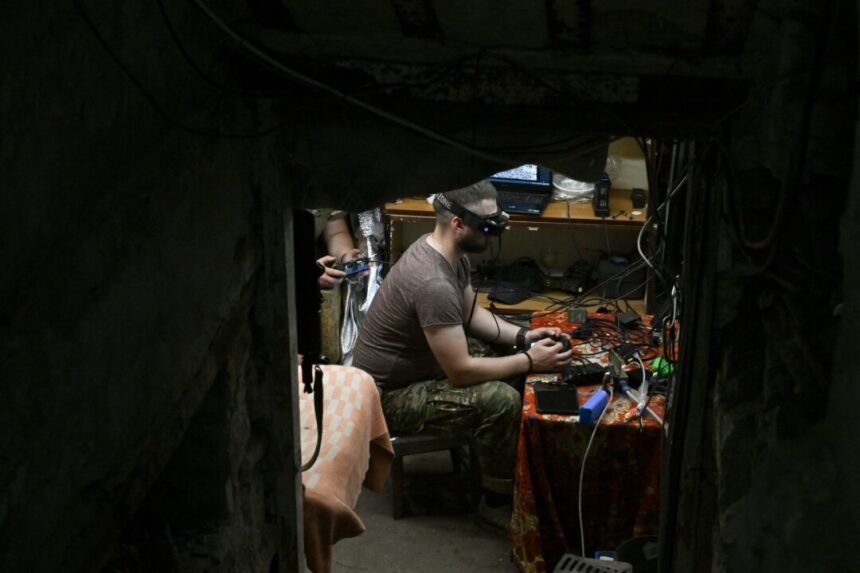Innovations that address real-world immediate needs typically deliver more bang for the buck than weapon systems developed in a far more leisurely fashion
Commentary
If you have been following the Russia–Ukraine war, you undoubtedly have been hearing about and seeing videos and photos of Russia’s ugly new wartime innovation—the “turtle tank.” The turtle tank is not a brand new tank; rather, it is a
modification of existing Russian tanks consisting of steel plating being mounted on tanks such as T-60, T-72, and T-80 variants. Along with the makeshift armor, many of the turtle tanks are also outfitted with anti-drone electronic warfare equipment, as well as sporting mine-clearing rollers.
While the additional armor is not very thick, it is thick enough to stop most of the weapons delivered by Ukraine’s cheap first person view (FPV) drones from directly impacting the Russian tank’s main armor. Further, such armor acts as spaced armor that can significantly reduce the effectiveness of anti-tank warheads delivered by weapons that depend on “shaped charges” to penetrate a tank’s armor.
The drone jamming equipment seen on some of the turtle tanks sports eight antennas and provides 360 degrees of coverage. Such equipment, as
reported in the Kyiv Post, has proven quite effective in disabling drones within a 360-degree zone of protection that extends well past the turtle tank to provide protection to other vehicles and soldiers.
Interestingly, far from being a package of enhancements produced via an expensive lengthy development process led by Russia’s military-industrial complex, it is believed that the first turtle tank was MacGyvered together by a former Ukrainian separatist unit that joined Russia’s regular army last year. This unit, now formally integrated into the regular Army as the
5th Russian Motorized Rifle Brigade, has a reputation for making do with whatever weapons or equipment it can beg, borrow, or steal. Apparently, the men of the 5th Rifle Brigade got tired of swarms of cheap, modified commercial FPV drones damaging, crippling, or destroying their tanks.
Of course, the turtle tank is no panacea, as while the relatively thin plating can disrupt the effectiveness of some anti-tank rounds or missiles, it will do little against others. Moreover, the makeshift armor will not save it from being destroyed or crippled by direct hits or very near misses by large-caliber artillery. And if it rolls over a tank mine that is not detonated by its de-mining equipment, it is going to be destroyed. What’s more, the armor interferes with visibility and severely limits the range of motion of its main gun, meaning its offensive power is severely impacted. Finally, the turtle mods slow down the tank and curtail its overall mobility.
Yet, starting with its first documented use by the 5th Russian Motorized Rifle Brigade, we have seen it increasingly
used as a breaching vehicle designed to clear the way for other vehicles and troops. That it is
being deployed in increasing numbers strongly suggests that it is providing value in mitigating the effectiveness of Ukraine’s FPV drones.
But whether it can defeat 10 or 20 or 30, etc., FPV drones, the really interesting point is that it was designed in the field and that doing so did not require the letting of a request for proposal, years of development, the testing of prototypes, delivery delays, and the cost increases one sees in formal weapons development programs.
This kind of innovation often happens in wars. Another obvious recent example of this is the innovative use of militarized cheap commercial FPV drones by Ukraine for reconnaissance and to attack troops, vehicles, and equipment. Another battlefield innovation is the integration of Elon Musk’s Starlink system into Ukraine’s military as a critical asset for communication, command, and control. And the
FrankenSam air defense system cobbled together by the U.S. military on behalf of Ukraine to address a desperate and immediate need for more air defense is yet another example of
successful, impactful battlefield innovations.
While the repurposing of cheap commercial drones for military use by Ukraine is arguably the most impactful battlefield innovation in the Ukraine–Russia war, Russia’s development of relatively cheap kits/modules that turn their vast stockpile of existing general-purpose bombs into precision-guided glide bombs has also been hugely impactful for them.
The modules, formally known as the
Unifitsirovannyi Modul Planirovaniya i Korrektsii (UMPK), which translates to unified gliding and correction module, were designed to be cheaper and easier to manufacture than Russia’s existing, expensive precision-guided bombs. And while the cost to develop and deploy the UMPK-enabled bombs is a fraction of the $600 million it took the United States/NATO to develop and deploy the JDAM-ER, they are similarly effective and appear to
more resistant to jamming than are
most U.S. weapons being supplied to Ukraine.
The above is just a small sampling of the documented and undocumented battlefield advancements and innovations that one sees during times of war. Such innovations address real-world immediate needs and typically deliver vastly more bang for the buck than weapon systems developed in a far more leisurely fashion via the formal, heavily bureaucratic development processes that dominate U.S. weapons development, as well as the weapons’ development of most Western countries.
Views expressed in this article are opinions of the author and do not necessarily reflect the views of The Epoch Times.







